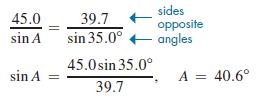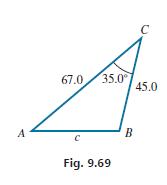Question: Solve the resulting triangles if the given changes are made in the indicated examples of this section. In Example 1, solve the triangle if the
Solve the resulting triangles if the given changes are made in the indicated examples of this section.
In Example 1, solve the triangle if the value of C is changed to 145°.
Data from Example 1
Solve the triangle with a = 45.0, b = 67.0, and C = 35.0°. See Fig. 9.69. Because angle C is known, first solve for side c, using the law of cosines in the form c2 = a2 + b2 − 2ab cos C. Substituting, we have

Now we will use the law of sines to find angle A (the smaller remaining angle).

Angle B can be found by using the fact that the sum of the angles is 180°: B = 180° − 35.0° − 40.6° = 104.4°. Therefore, c = 39.7, A = 40.6°, and B = 104.4°. After finding side c, solving for angle B rather than angle A, the calculator would show B = 75.5°. Then, when subtracting the sum of angles B and C from 180°, we would get A = 69.5°. Although this appears to be correct, it is not.

unknown side opposite known angle c= 45.0 + 67.0 2(45.0) (67.0)cos 35.0 c = 45.0 + 67.0 2(45.0) (67.0)cos 35.0 -known sides 39.7
Step by Step Solution
3.42 Rating (165 Votes )
There are 3 Steps involved in it
In Example 1 we have a 450 b 670 C 350 Using the law of cosines we can find the third side ... View full answer

Get step-by-step solutions from verified subject matter experts


